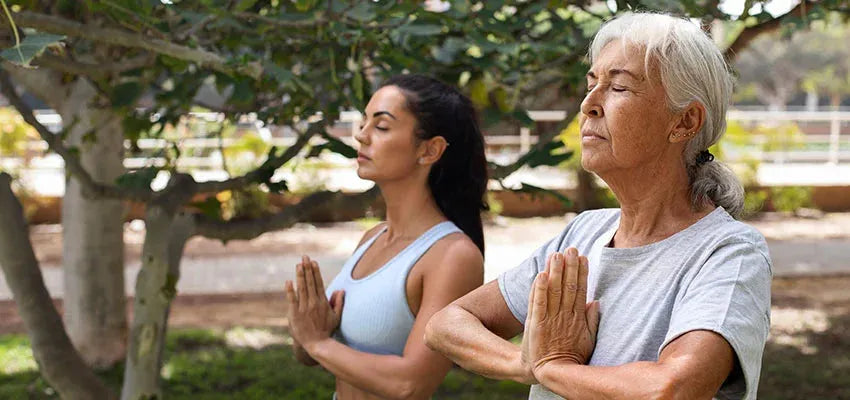
Should you slow down your active life with age?
With advancing age, it becomes important that we remain active to maintain a healthy life. Contrary to popular belief, older people require some form of physical activity to keep themselves fit. Indulging in regular physical activity of some form helps manage your weight, improves brain health, strengthens the bones and muscles, and reduces the risk of developing diseases caused due to sedentary lifestyle. A person can reap these health benefits of physical activities irrespective of age and gender.
What is aging?
Aging is an inevitable and irreversible process that takes place progressively as a person advances in age. Some of the evident signs of aging are drooping eyelids, uneven and dull skin tone, open pores, fine lines and wrinkles, etc. Other than these, there are 5 physical changes the elderly experience with the passage of time as mentioned below:
Bones, muscles, and joints: Aging causes bones to shrink in size, muscle mass to decrease, and joints to lose their strength and flexibility. For this reason, some older people appear to be frail and shorter in stature.
Digestive system: The process of digestion becomes affected as we age. No longer does the flow of digestive secretions from the stomach, liver, small intestine, and pancreas remain the same as it was during the younger years. Swallowing becomes difficult because the esophagus contracts with lesser force.
Heart:This is perhaps the most vital organ of the body that pumps blood day and night. As a person ages, the blood vessels tend to lose their elasticity and harden due to deposits on the internal walls. As a result of these deposits, the heart has to work harder to circulate blood efficiently throughout the body. Conditions such as atherosclerosis (hardening of the arteries) and high blood pressure (hypertension) are most likely to develop in such cases.
Kidneys and urinary tract: The kidneys shrink in size and become less capable of eliminating wastes from the bloodstream. Chronic health issues that are common with the elderly such as diabetes and high blood pressure, cause even greater damage to the kidneys. Urinary incontinence also becomes a part of life for the elderly population.
Brain and nervous system: Memory loss is a sign of aging as the number of brain cells decreases. Reflexes can get affected and coordination becomes difficult.
Apart from the above physiological changes, there may be changes in vision, hearing capacity, and weight management issues.
Factors affecting the aging process
The process of aging varies from person to person. In some individuals it may start early and be more pronounced. Some of the factors that contribute towards aging are as follows:
Hormonal imbalances: Changes in hormone levels as we age is a key contributor towards the aging process. The decline in certain hormones such as testosterone and estrogen can trigger the onset of diseases that are common during old age. Example: Osteoporosis.
Genetics:Genetics plays an important role in aging. Some hereditary variations are known to increase the risk of age-related diseases such as Alzheimer’s disease. There is a high possibility of such disease-causing genes passing on from one generation to the next.
Lifestyle factors: Lifestyle choices that we make such as diet and physical activities can impact the aging process. Leading an active lifestyle that includes eating a healthy, balanced diet, staying mobile with some form of physical exercise, and saying no to smoking and alcohol consumption can delay the aging process.
Environmental factors: Prolonged exposure to pollution, allergens, and toxins can hasten the aging process.
Chronic illness: Diseases such as diabetes and hypertension are mostly age-onset diseases. Such comorbid conditions contribute to early aging in individuals.
Physical activity benefits for older adults
Physical activity for older adults not only helps in maintaining their physical health but also keeps their mental health sharp. The benefits that one can reap out of an active lifestyle are manifold and discussed briefly below:
Helps maintain an ideal weight: With time, it becomes difficult to maintain an ideal weight, keeping in mind that our metabolism slows down naturally. Any form of regular exercise becomes essential to aid our failing digestion by increasing the metabolic rate. The body finds it easier to burn the extra calories which would otherwise have accumulated in the body in the form of fat.
Enhances immunity: Leading an active life helps increase our mobility and agility during the older years. If one remains sedentary, it can lead to the development of chronic diseases such as osteoporosis, diabetes, hypertension, etc. Keeping yourself on your toes goes a long way in improving immunity and keeps chronic illnesses at bay.
Improves mobility and flexibility: Some form of physical activity is best to keep your bones, muscles, and joints functioning to their optimum level. Healthy joints will help you maintain your balance and coordination, preventing falls from taking place.
Results in good sleep: Having a restful sleep as you grow older is vital for keeping you fresh and feeling energized. Engaging in some form of physical activity will help in falling asleep quickly and easily.
Boosts general well-being: Physical activity can bring great relief to the mind as it helps release endorphins that help to relieve stress. Exercise can actually help in reducing feelings of sadness, anxiety, and depression.
Aging is a very natural process that takes place gradually in everyone’s life. While some embrace it graciously and make the remaining years of their life count, others get limited to the idea of taking to the rocking chairs! It’s high time we break free of this stereotypical mindset and make efforts to stay healthy as we grow older. It is recommended to consult healthcare professionals who can expertly guide us on activities and exercises that can help us remain fit longer!


